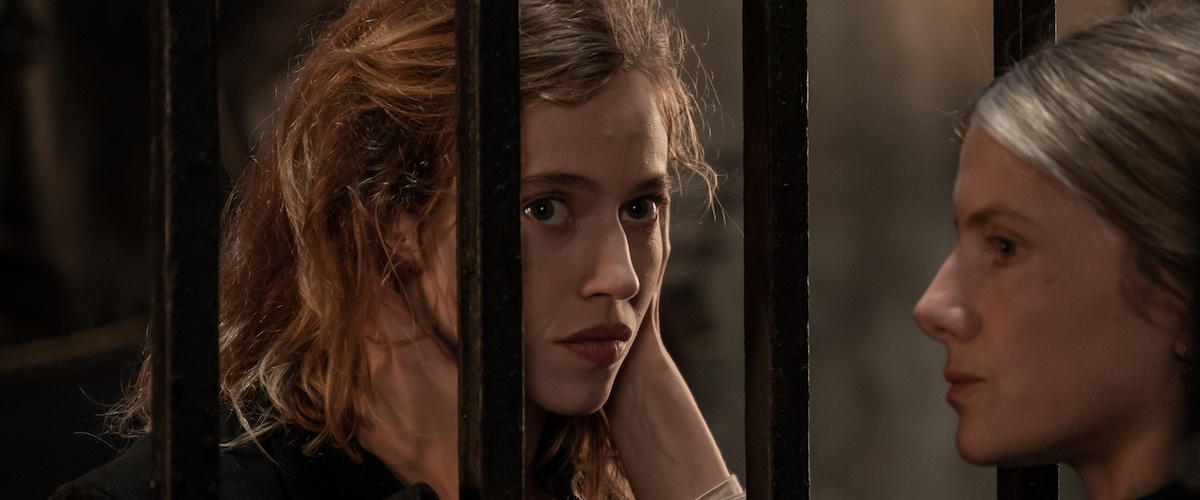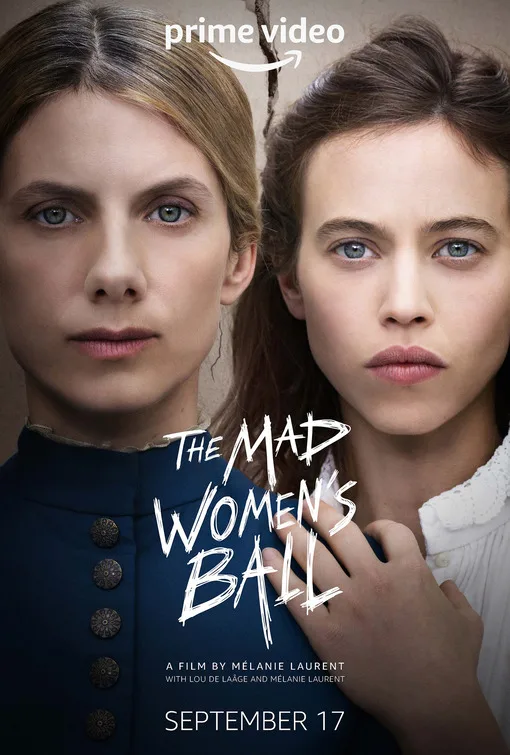There’s a famous 1887 painting by André Brouillet called “A Clinical Lesson at the Salpêtrière.” In it, a room full of men watch a strange demonstration going on at the front of the room. A man stands beside a table covered in medical instruments. A woman in a loosened corset, her breasts nearly exposed, swoons into the arms of a man. Her left hand clenches in a claw. This disturbing tableau depicts neurologist Jean-Martin Charcot, celebrated for what was considered his groundbreaking treatment of the mentally ill at the Pitié-Salpêtrière asylum in Paris. He would often give demonstrations of his methodology, using actual patients. This painting is recreated in Mélanie Laurent’s “The Mad Women’s Ball,” a compelling and vivid adaptation of Victoria Mas’ novel about two women trapped—in different ways—behind the gates of the Salpêtrière during Charcot’s reign.
“The Mad Women’s Ball” is part psychodrama and part melodrama, and it wears those mantles proudly and confidently. Each scene throbs with urgency and emotion. Nothing is unimportant. At the same time, the film is highly controlled, with a taut assured script. Laurent, who also did the adaptation, deftly loops together two separate narratives, running side by side at top speed until they intersect.
Eugénie (Lou de Laâge), a wealthy but rebellious young woman, is committed to the Salpêtrière against her will by her father (Cédric Kahn), who is concerned that his daughter occasionally talks (and listens) to the dead. She is thrust into a building more dungeon than hospital, filled with the howls and wails of women. Laurent, an accomplished actress, most well-known for her role in “Inglourious Basterds,” plays Geneviève, the head nurse, present at Eugénie’s traumatic intake. Geneviève is smileless and cold in the face of Eugénie’s terror. It appears at first that Geneviève is Nurse Ratched. Cold waters run deep, though. Geneviève is full of surprises.
The dormitory is a nightmare, with women screaming and fighting or lost in catatonic states. A vivacious patient named Louise (Lomane de Dietrich) takes Eugénie under her wing. Louise tells Eugénie about her fiance, a doctor, and there’s something a little too frantic about this declaration. It turns out that, unsurprisingly, all kinds of horrible things happen behind those huge gates: exploitation, needless cruelty, and sexual assault. Taken all together, these things don’t just perpetuate madness, but create it. Many of these women are not “mad” at all. They are high pitched, perhaps, or “hysterical” (in the parlance of the day), some have epilepsy, and—in the case of Louise—clear evidence of sexual trauma. The treatments—bloodletting, magnet therapy, hydrotherapy, isolation—are barbaric. Occasionally, one of these traumatized women is wheeled out in front of an audience, the men in Brouillet’s painting, to be hypnotized by Charcot (Grégoire Bonnet). Charcot has turned the asylum into a showplace, culminating with a grotesque costume “ball,” where the public comes to gawk at the “mad women,” all of whom are in costume.
Eugénie’s problem is not that she’s “mad.” It’s that she really does speak to the dead, and she refuses to recant, even under extreme pressure. How she ends up using the gift that got her into so much trouble is one of the joys of this often upsetting film. It’s not what you would expect, and it involves Geneviève. In so many ways, women’s “whisper networks” are the real story here, how women pass on information surreptitiously, unseen by the misogynistic culture wielding its power over them.
Laurent pays careful attention to all of the women in the dormitory, allowing them to be individuals, not just a generic backdrop for Eugénie’s journey. Laurent’s approach fills the scenes with life: characters emerge, stories, tragedies, whispered and passed along. The film doesn’t “gawk” at the women like the men at the demonstration do. The film loves them, cares about them.
The climax, taking place during the macabre “ball,” is a wonder of scene construction (the film was edited by Anny Danché). Multiple storylines come to a head simultaneously, and the sequence is propulsive, tense, thrilling even. Asaf Avidan’s simple yet effective score is used throughout, mournful cellos and anguished violins throbbing underneath the scenes. Cinematographer Nicolas Karakatsanis shot the film with sensitivity and care: the camera moves only when it has to, and when it does move it helps intensify the film’s momentum. There is one sequence made up of a series of eerie still lifes: china tea pots, damask curtains, silver hairbrushes … the detritus of a woman’s life, what a woman will leave behind. It’s not much. The color palette is muted, all dark blues, greys. You can smell the mold of those dank damp dungeon walls.
This is Laurent’s fifth film as a director, but her first of such size and scope (and her first period drama). She uses different visual motifs again and again, in thoughtful and precise ways. There are multiple lingering shots of the backs of women’s heads, be it Eugénie, Geneviève, or the sadistic Nurse Jeanne (Emmanuelle Bercot). The film opens with a shot of the back of Eugénie’s head, among the crowds flooding the streets for Victor Hugo’s funeral. She never turns around. We are left to wonder: Who is she? What is she thinking about? What’s in her head? As the shots accumulate, these questions intensify their demand. With all the blather about mental health, all the bragging about “curing” the patients, there’s absolutely no curiosity about what might be going on in their heads. The women’s feelings about their own lives could not be more irrelevant.
Melodrama gets a bad rap, but it has always been an effective container for getting out certain messages, for providing space for social commentary, for addressing common “ills” of the world. Melodrama can be over-blown, over-heated, sentimental. “The Mad Women’s Ball” is none of those things. Laurent’s control over the material reaps huge rewards.
Now playing on Amazon Prime.




















